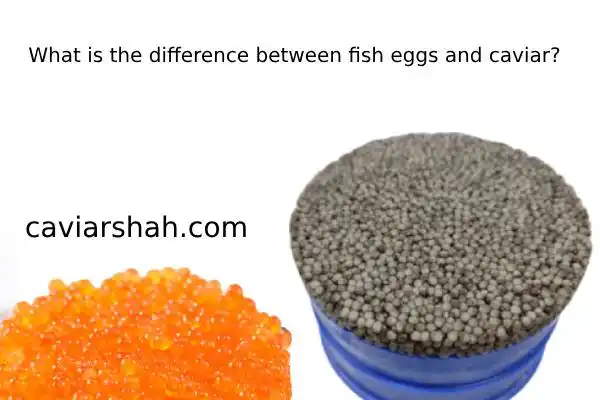any form of processing, fish eggs are referred to as sea fish eggs. Although caviar is sometimes known as the egg of any marine animal after processing, it is often understood that caviar is the egg of a banded fish. To put it plainly, fish eggs are not the same as caviar.
Fish roe is less expensive than caviar (Especially Iranian beluga caviar) and is highly beneficial in northern Iranian cuisine. In the provinces of Gilan, Mazandaran, and other northern regions of the nation, fish roe is eaten as an appetizer and is extensively utilized in cuisine.
Fish vary from one species to another and from one fish to another with regard to color variance in their caviar. In addition to being substantially more expensive than fish eggs, caviar differs from fish eggs in terms of protein, fatty acids, and other nutritional value.

What is the difference between fish eggs and caviar?
Fish eggs are defined as fish eggs in the Dehkhoda lexicon, the language used by the Gil people, since the people of Gilan take the eggs out of the fish’s belly and stew them whenever they like.
Fish eggs are the term used to refer to raw fish eggs in the dialect spoken in northern Iran. In northern Iran, fish roe is utilized in a variety of recipes. In this area, fish eggs are generally referred to as Caspian sea fish eggs, which resemble white fish.
The refined egg of aquatic creatures, of which crustaceans are the most well-known, is called caviar. Caviar differs from fish eggs in terms of size and color.

Distinguishing original caviar from counterfeit
Examining genuine caviar closely is the first step in differentiating it from false Keep in mind that there shouldn’t be any plaque on the caviar and that the caviar container shouldn’t be filled with liquid. The caviar in the dish shouldn’t be in the form of grains or lumps that adhere to one another. Good caviar has a subtle marine scent that is not the same as that of leftover fish. In water, real caviar does not change color.
Real caviar is unique to a certain kind of fish in terms of both color and size. The characteristics of real caviar that set it apart from fake caviar include its highlights and shadows, as well as its cloud and wind patterns. Always be mindful of the caviar’s density. If you tilt the caviar container, the grain should not stick to the container or remain in a lump.
Our suggestion is that if you want to try caviar for the first time, use beluga caviar 30g.

The fundamental flavor of caviar has a nice buttery flavor that can occasionally be enhanced by a very slight sweetness or bitterness. If its flavor changes in any way, the caviar is not natural.
One of the common indications that the caviar is authentic is that its grains readily burst on the tongue when it is placed in the mouth. Seaweed and colored gelatin grains are stretchy.
While imitations of synthetic chemicals or gelatin dissolve readily in water, real caviar seeds do not dissolve in boiling water.
What is the packaging of sturgeon caviar?
Before being packaged, caviar is treated using food-grade salts. Caviar is packaged and marketed between two and four degrees. Because caviar loses quality when it freezes, it is not permitted. The following characteristics apply to caviar packing containers: Tins are made of metal that has been lacquered and sealed. Food-grade containers include glass and various types of containers. Products may be repacked as long as regulated environments are maintained and the product’s quality and safety are not jeopardized. It is forbidden to combine different fish species’ caviar.
References
- Mozaffarian, D., & Rimm, E. B. (2007). Fish intake and cardiovascular health. Circulation, 115(23), 2664-2685.
- Barceló-Cobos, R., & López-Feria, A. (2014). Fish roe: A nutritional source of health. Journal of Ocean University of China, 13(4), 529-541.
- Santos, C. C. C. (2019). Nutritional composition of fish roe. In Fish roe: From culinary delicacy to dietary supplement (pp. 1-16). Springer, Cham.
What is the best way to store sea fish eggs?
Sea fish eggs should be stored in the refrigerator in an airtight container. They will keep for up to 2 weeks.
Are there any risks to eating sea fish eggs?
Sea fish eggs can be a source of bacteria, so it is important to cook them thoroughly before eating them. Pregnant women and people with weakened immune systems should avoid eating raw sea fish eggs.
What are the health benefits of sea fish eggs?
Sea fish eggs are a good source of protein, omega-3 fatty acids, and vitamins A and D. They are also a good source of choline, which is important for brain health.








